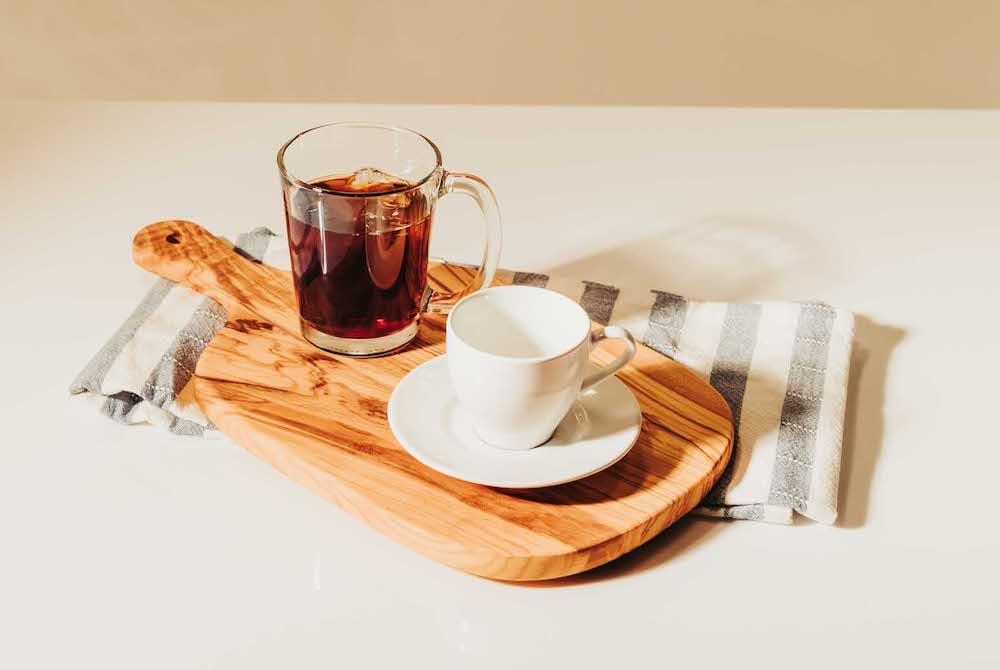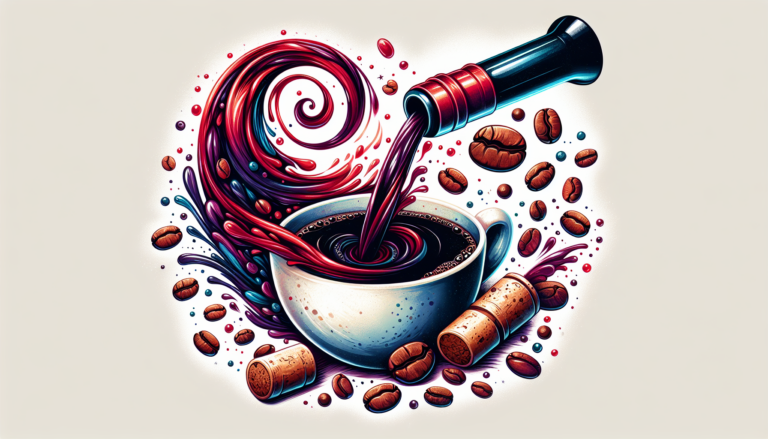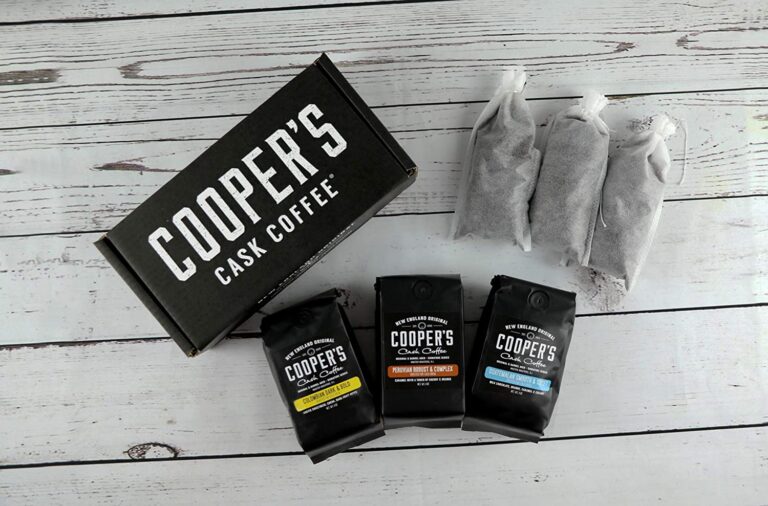Around the world, each region that produces our distinctive coffee beans imparts its own unique flavor to the roast and the brew. That’s why Cooper’s Cask Coffee uses single origin coffees in all our coffee products.
But what about those flavored coffees you find in big box stores? Maple flavored coffee. Coconut Caramel Crunch flavored coffee. Pumpkin Spice flavored coffee. What region did they come from? We think Dante knows—#8 in his epic poem, to be exact.
You can enjoy naturally flavored coffee without having to resort to unnatural chemicals. Read on for fun ways to get creative in your cup.
The Secret Behind Mass-Produced Flavored Coffee
How do they do it? How do big coffee makers put a taste resembling a doughnut, a candy bar, or a pie, into their coffee beans?
They do it with chemicals, that’s how.
For example: have you ever used artificial vanilla? It’s kind of like vanilla, and tastes similar, right? However, the “vanillin” in artificial vanilla usually comes from the waste produced by wood pulp manufacturers. Yeah, wood pulp—as in, what goes on to make paper.
Yum, huh?
Why do they do this?
When big manufacturers spray “taste adjacent” chemicals all over roasted beans and tumble them in this goo, it saves the producer time and money compared to a natural infusion process. Plus, they create an unnatural array of artificially flavored coffee to put on store shelves.
With these mass-produced flavored coffees, you lose the character of the original bean as it’s buried under the flavoring compounds. This might also be the way big producers mask the use of sub-par beans. If you put so much flavoring agent on poor quality coffee, the end user can’t taste the difference.
It’s even used to mask stale beans. At Cooper’s Cask Coffee, you’ll find the roast date and batch number hand-written on each bag by our master roasters. You know for a fact how fresh your coffee is. For much of the coffee you buy at the grocery store, “fresh” is sadly a marketing ploy instead of a promise.
Look, we won’t judge you if you like those coffees. OK, maybe a little—but we get it. However, you can have a lot more fun making DIY naturally flavored coffee, and a lot more satisfaction in your cup.
Related topic: understanding the different coffee brew methods.
Make Your Own Naturally Flavored Coffee
Enough about those mocha bananas foster leche caramello beans. Let’s talk about ways you can put delicious flavor naturally into the roasted single origin coffee beans from Cooper’s Cask Coffee.
We’ll look at 3 different ways to add flavor: wet infusion, dry infusion, and flavoring the brew.
First, Pick Your Coffee
Our single origin coffees all list their flavor profiles on our site. That makes it easier for you to choose your starting point. Take our Rwanda Medium Roast Coffee for example. It offers rich and sweet flavors as a brewing base. Or choose Brazil Medium Dark Roast Espresso, with notes of creamy brown sugar, black cherry, and sweet orange.
When you’ve chosen the coffee, you can decide on the flavors to infuse that compliment the beans’ base flavor profile.
Option 1: Let’s Get Infusing!
You can infuse roasted coffee beans in a wet way, or a dry way.
Wet Infusion
Because your coffee beans arrive with 11% moisture, they’re dry—and can absorb liquids. Normally this would be a bad thing, unless you’ve ground them and are brewing a cup or pot.
But, if you’re infusing, you can find natural flavorings that can be absorbed into the beans. Then, you can dry them slowly and carefully, either in a dehydrator or spread across a pan in the oven on an extremely low setting. That last thing you want to do is re-roast your beans!
Coatings for Wet Infusion
Imagine how certain flavors would go with the flavor profile of the roasted coffee, and use those to create your wet infusion.
Water or Alcohol
If it’s sweet with dark fruit overtones, maybe a wet infusion made of cloves or cardamom suspended in water, pure grain alcohol, or non-flavored oil would work nicely. Spread the beans out on a sided cookie sheet, then sprinkle the wet infusion across them.
Once you’ve got them as evenly coated as possible, put the beans in a lidded container that can hold at least 50% more volume than the beans. Gently shake the beans for a minute or so, working to get as much of the wet infusion spread across them as possible.
Then, dry the beans in your oven or dehydrator and let them sit in an airtight container for a week. After that, use them within the next couple of weeks for best freshness and flavor.
Natural Oils
Natural oils exist for flavoring, such as vanilla (not vanillan, and you don’t even wanna know about castoreum!!), cocoa oil, or even mint. Spread your infusion beans out on a tray with sides on it. Take a small small sprayer/spritzer bottle, and add some of your chosen oil (or oils) and grain alcohol at a 50/50 ratio.
Spritz your roasted beans, shake the pan, spritz them again, and then let them dry either in a dehydrator or in the oven on a very low setting.
Store your dry, infused beans in an airtight container for a week, and use the batch within 2 to 3 weeks after that for best flavor of the bean and the infusion.
A Word About Syrups
We’re not fond of infusing roasted beans using syrups because of the sugar that’s involved in creating the syrup. You or your other coffee lovers may not like a sweetened coffee.
However, the fact is you can flavor with syrups, again drying the beans when you’re done coating them. Use them within 2 to 3 weeks of coating.
Option 2: Dry Infusion
A dry infusion involves no liquids. It’s similar to how we infuse our barrel-aged coffees: by allowing the beans to absorb the aromatic flavorings of the added elements.
The big difference is that our barrel aged coffees use green, unroasted beans. You’ll be using roasted beans, which won’t absorb flavors as readily. It’s not impossible to do, but expect the flavors to be lighter, and perhaps more impactful for your nose than for your tastebuds.
To dry infuse your beans, take a strongly aromatic, natural flavoring agent such as cinnamon sticks, vanilla sticks, shaved nutmeg or cloves (in tea infusion bags), or some other fragrant spice or flavor, and add it to your beans in a closed, airtight container.
Store it in a cool, dark place for a week. Shake the container twice per day during that time, so that as many beans as possible can be in contact with and adjacent to the flavoring compound.
After the week, use your beans while leaving the flavorings in the rest of the beans to continue infusion. We don’t recommend grinding your beans with the flavorings in them, as they will also flavor your grinder for some time after that.
Use your infused beans within 2 to 3 weeks after the infusion.
Option 3: Do It When You Brew It
As the third and lowest effort option, you can add spices or flavorings to your grounds before brewing, or directly in your cup.
If you add spices/flavorings directly to your grounds, you can use powdered ones as well as more whole pieces. Keep in mind the size of your filter’s holes. Adding powdered spices/flavoring to brew methods that don’t use finer mesh screens or paper filters can add grit to your brew.
Rule of thumb: if the brew method uses a coarse grind, use bigger pieces of flavoring.
In the Cup
Make your naturally flavored coffee on a per-cup basis by adding solid flavorings directly to your mug. Vanilla sticks do amazing flavor additions in fairly short order. You’ll have to experiment on infusion times to see what works best for your palate. We recommend 15 to 30 second intervals, with sip tests in between.
Cold Brew Too
Add a vanilla stick to your cold brew, and get ready for a refreshing drink! Other additives work, too. Just remember that cold brew is often unfiltered, so use the bigger pieces of flavoring.
Have Fun With Our Barrel Flavored Coffees
You don’t have to infuse just single origin un-infused coffees. Imagine cinnamon and rum using our Rum Barrel Aged Coffee. Or vanilla and bourbon using our Bourbon Barrel Aged Coffee. Be the mad scientist in your kitchen, and enjoy the process as you enjoy the results!
You should check out our Gourmet Mexican Coffee recipe. It uses cinnamon sticks, star anise, cloves, and even orange peel in the brewing process. The results? Amazing.
Related topic: how to brew whiskey coffee.
The Point of Naturally Flavored Coffee
Adding a natural flavor to your beans or your brew is meant to complement, and perhaps emphasize, the flavor of the coffee itself. It’s not meant to replace it.
When you order your single origin beans from Cooper’s Cask Coffee, our team of coffee snobs make sure you receive coffee that’s freshly roasted to peak perfection. Our intense cupping process roasts the beans at 5 degree increments, and we taste-test them all the way through. In the end we choose the roast temperature that brings out the best flavors of the coffee.
The same should be done with your natural flavorings, experimenting to find the right flavoring combinations and strengths so that you can enjoy all the complexities of your gourmet coffee experience.
Try it with 10% off
Sign up for our newsletter and get 10% off your first purchase!
If you’re already a customer of Cooper’s Cask Coffee, first of all- thank you. Keep your favorite coffees in stock with our subscription service. Pick the frequency that works best for your lifestyle, then coffee on!
Cooper’s Cask Coffee for Perfect Coffee Pleasure
Not to brag (but we’re going to), we have over 7000 4- and 5-star reviews on Amazon. We’re confident enough in the quality of our coffees that we offer a 100% satisfaction guarantee.
If within 30 days of your order you aren’t wholly satisfied, you can trade it out for another coffee, or send your order back postage-free and we’ll return your money.
Small batch, big satisfaction. Cooper’s Cask Coffee.
Sign up for our email list and get 10% off your first order!


